2024 Frontiers in Science: Climate Action
Apr 22, 2024 — Atlanta, GA

Susan Lozier, Julia Kubanek, L. Beril Toktay, and Tim Lieuwen
This Earth Month more than 100 campus and community stakeholders gathered near the Georgia Tech EcoCommons for the 2024 Frontiers in Science: Climate Action Conference and Symposium.
On April 18, the College of Sciences hosted more than 20 speakers and panelists from across the Institute and Atlanta community presenting groundbreaking research and discussing innovations and ideas in climate change, challenges, and solutions.
Georgia Tech President Ángel Cabrera (M.S. PSY 1993, Ph.D. PSY 1995) kicked off the morning sessions by highlighting the Institute’s new Climate Action Plan, which outlines the pathway to achieve net-zero emissions by 2050. Cabrera’s remarks focused on Georgia Tech’s role on the frontlines of research and education informing how we respond to climate challenges — and noted that the Institute’s work must extend beyond our laboratories and classrooms.
“It is essential that we not only do the science, but that we also tell that science to the world,” Cabrera says.
Interdisciplinary inquiry
This year, Frontiers in Science featured an array of climate research and initiatives led by the College of Sciences, fellow colleges across Georgia Tech, and the wider Atlanta community.
Following a three-year hiatus of the Frontiers series, the 2024 edition re-envisioned the signature annual event as a research conference and symposium to convene campus experts — and to incubate seed grant proposals to support the work of early career faculty.
Frontiers previously hosted Nobel laureates and invited thought leaders for individual talks across the College’s six schools, and celebrated milestones like the International Year of the Periodic Table of the Chemical Elements.
“This year, we wanted to showcase what we are doing right here in the College of Sciences and throughout the Institute,” says Susan Lozier, dean of the College of Sciences, Betsy Middleton and John Clark Sutherland Chair and professor in the School of Earth and Atmospheric Sciences. “Our faculty are at the forefront of broadening our knowledgebase and uncovering solutions in areas critical to the planet and our well-being. We wanted to uplift that work and see what sort of connections could be made.”
Connections and collaboration were key themes of the day as faculty, staff, students, and alumni participants representing all six Georgia Tech colleges shared research results and ongoing work and discussed collaborative ideas for horizons ahead.
“Scientists alone cannot [create accurate models],” noted Annalisa Bracco, professor in the School of Earth and Atmospheric Sciences and associate chair for Research, who shared her own research alongside Lozier, who presented a version of her 2024 TED Talk on ocean overturning. “Engineers alone cannot do it. We need social scientists, policy makers, communicators.”
The importance of an interdisciplinary approach was reinforced by the Strategic Energy Institute at Georgia Tech (SEI) and Brook Byers Institute for Sustainable Systems (BBISS), which announced an interdisciplinary seed grant funding opportunity for assistant professors with ideas for new climate solutions.
Frontiers in focus
Across three themed sessions, faculty and leadership from the Colleges of Sciences, Engineering, and Design spearheaded talks on the ocean and cryosphere, biodiversity, carbon cycling, coastal wetlands, biofuels production, and beyond.
Panels on climate challenges across community, technological, and policy initiatives were hosted by Georgia Tech Vice President for Interdisciplinary Research and Professor in the School of Biological Sciences and the School of Chemistry and Biochemistry Julia Kubanek.
Following a networking lunch with climate table topics, Georgia Tech Executive Vice President for Research and Professor in the School of Electrical and Computer Engineering Chaouki T. Abdallah (M.S. ECE 1982, Ph.D. ECE 1988) kicked off the afternoon sessions — which also announced the scholarship recipients of a student video competition and featured videos with a pair of alumnae working in meteorology, climate research, and policy.
Afternoon highlights also included discussions on the Georgia Tech Climate Action Plan and Sustainability Next initiative, led by Jennifer Chirico (B.S. MGMT 1997, Ph.D. PUBP 2011), associate vice president of Sustainability for Georgia Tech Infrastructure and Sustainability, and Jennifer Leavey (B.S. CHEM 1995), assistant dean for Faculty Mentoring in the College of Sciences and interim assistant director for Interdisciplinary Education in the Brook Byers Institute for Sustainable Systems.
Although many of the presentations provided a stern outlook of the state of our ecosystems, the conference concluded with a sense of hope. This optimism was grounded in the range of opportunities that exist to address climate challenges — thanks, in part, to the body of knowledge and solutions being tested and explored by Georgia Tech researchers.
At the end of the day, Katie Griffin, a first year undergraduate student in Environmental Science, read Amanda Gorman’s poem Earthrise and provided this reminder:
All of us bring light to exciting solutions never tried before
For it is our hope that implores us, at our uncompromising core,
To keep rising up for an earth more than worth fighting for.
Experience the event in pictures with the College of Sciences’ Flickr account, and discover the highlights through the day’s live tweets on College of Sciences’ X account.
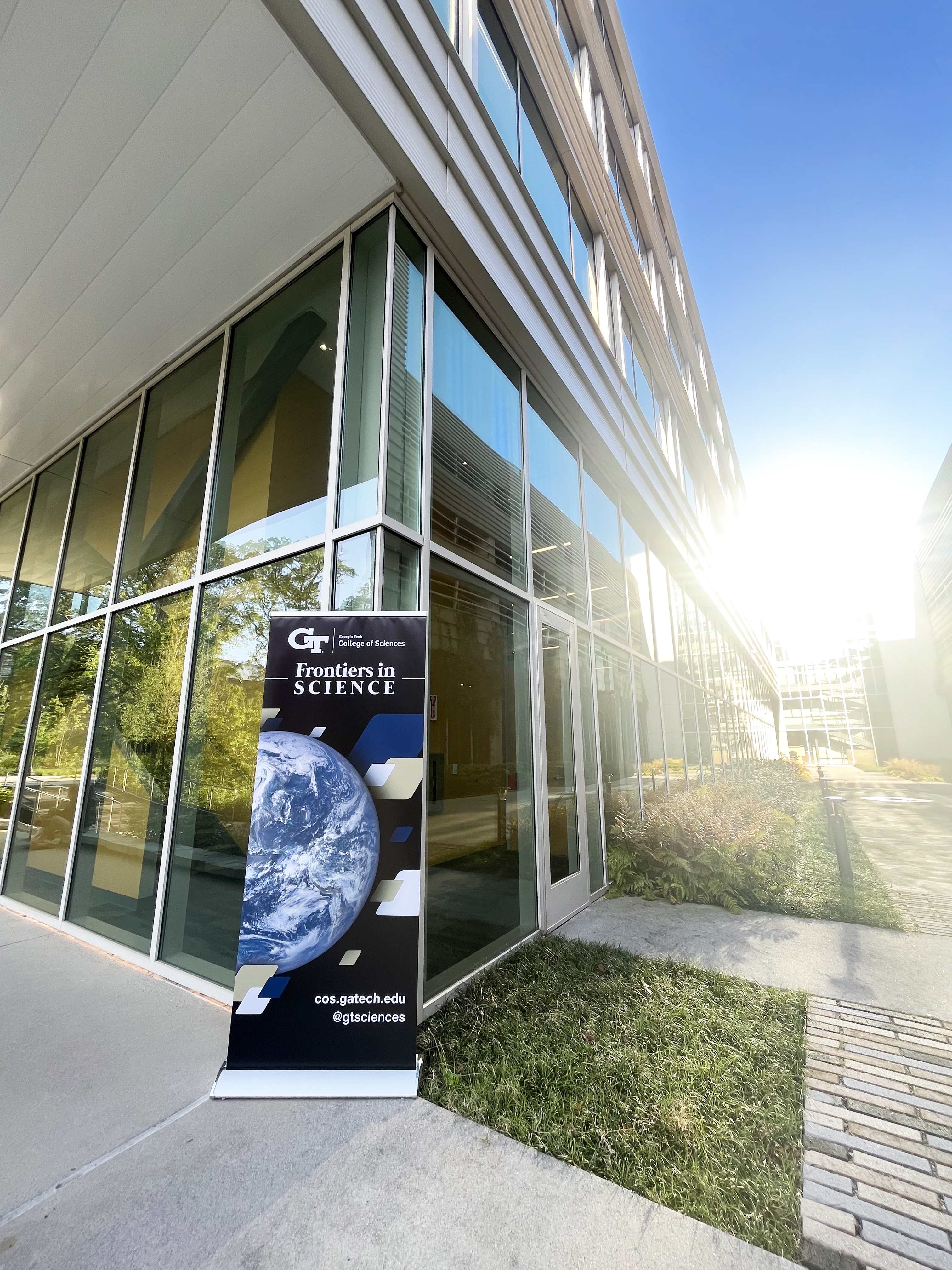
Frontiers in Science Banner Outside at Sunrise
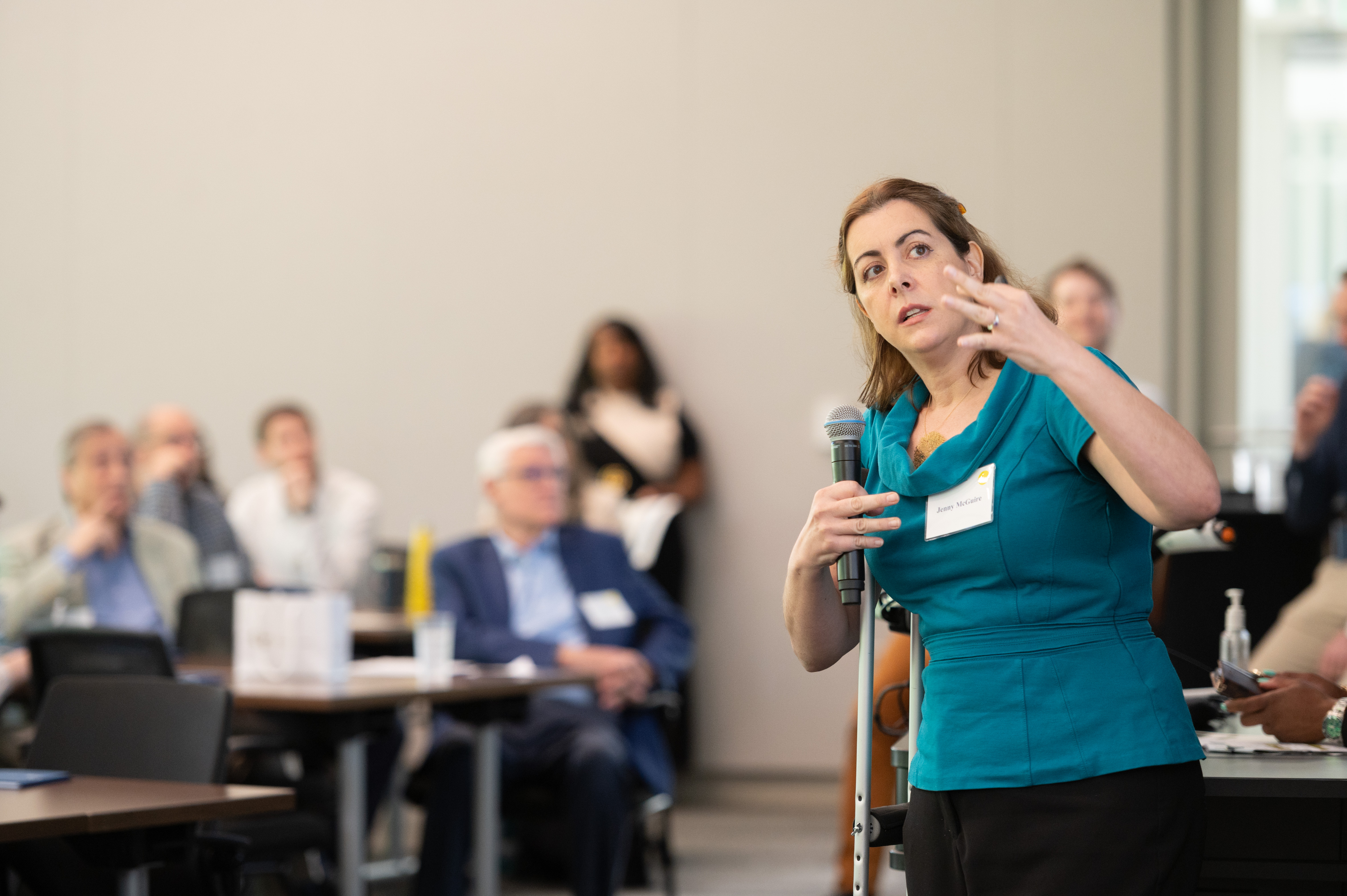
Jenny McGuire
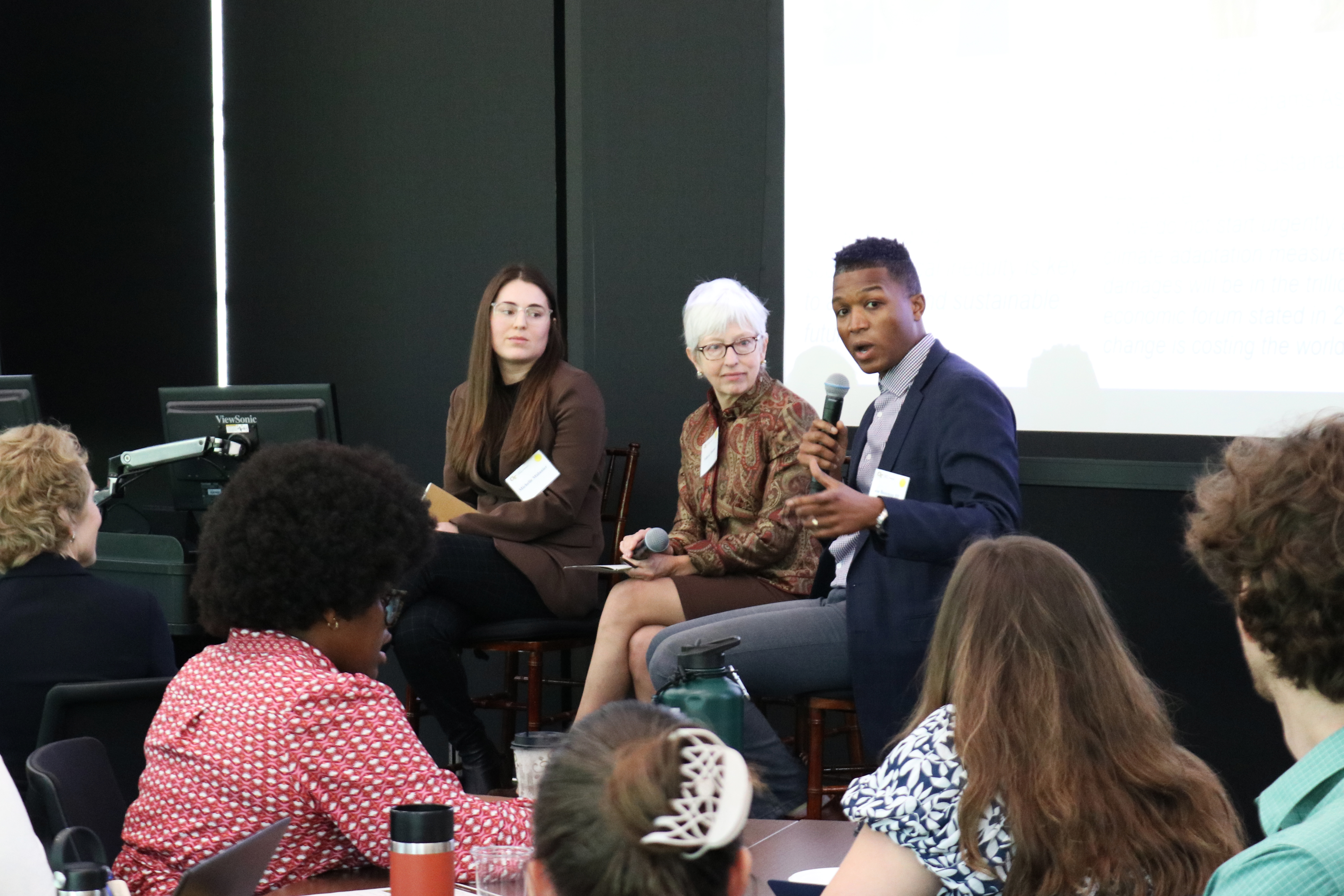
Frontiers in Science Policy Discussion Panelists: Michelle Midanier, Valerie Thomas and Joe F. Bozeman III
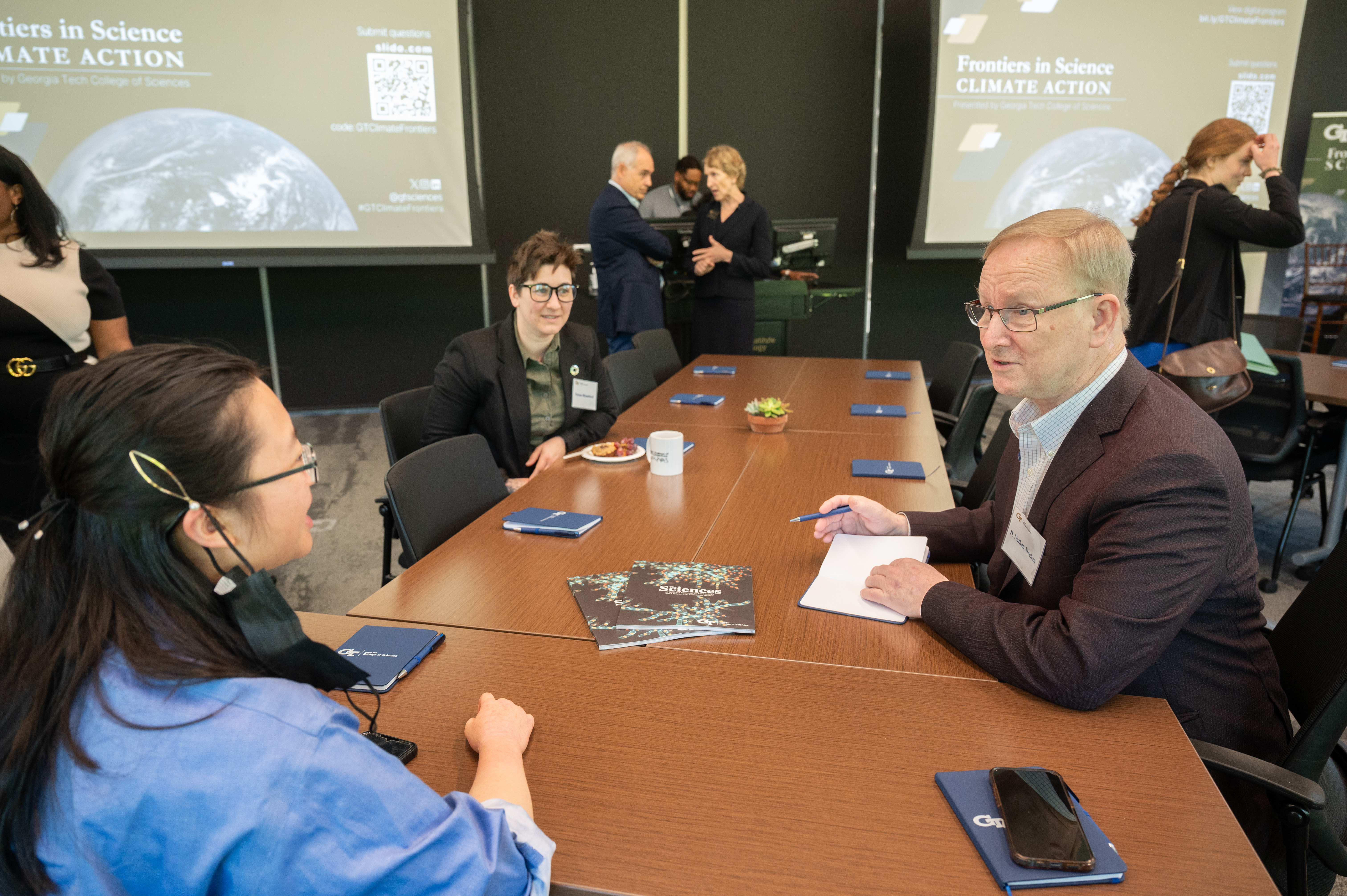
Frontiers in Science Participants
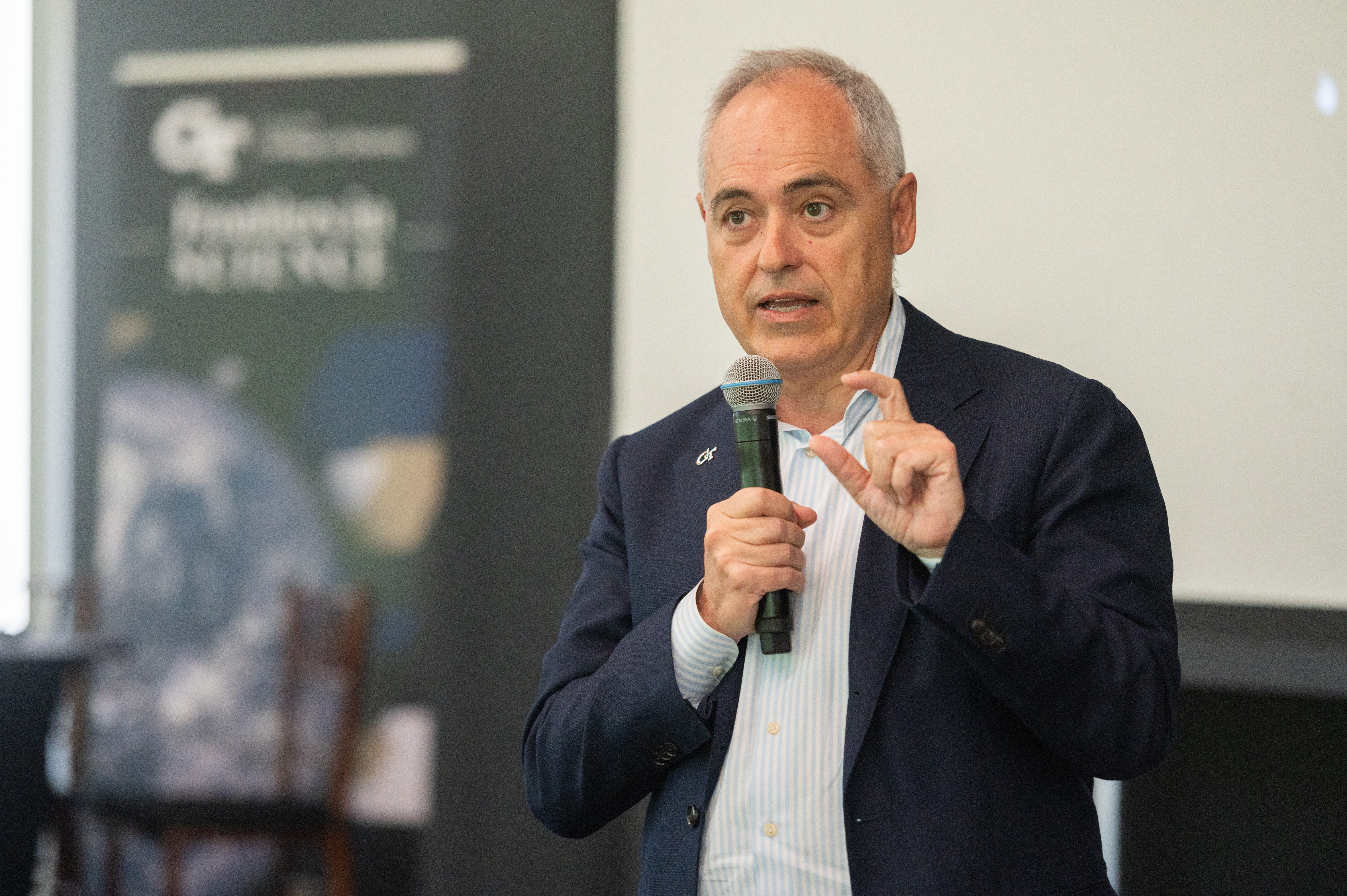
President Ángel Cabrera
By: Lindsay Vidal
Jess Hunt-Ralston
Director of Communications
College of Sciences at Georgia Tech
Community Spotlight - Tamsin Leavy
Apr 10, 2024 —

Written by Benjamin Wright
Tamsin Leavy is a self-described “Australian-born Jersey girl” who has lived in, among other places, Montana, Massachusetts, England, Philadelphia, and in an eco-village in Ithaca, New York. Moving around so much made it hard to put down roots, but now that she’s in Atlanta working as the Georgia Tech community garden coordinator, she’s finding that roots are a big part of her day-to-day.
Tamsin started her career working in anthropology and archaeology before pivoting to teaching social studies and history. While working as a teacher in a New Jersey food desert she was stunned at how little access some of the students had to nutritious food. She had grown up around family gardens and fresh grown produce and saw an opportunity to help students access fresh food. With a rekindled love for gardening and plants Tamsin went back to school to earn a horticulture minor from Oregon State University and then sought out ways to combine education and horticulture.
That’s how she landed at Georgia Tech where she is supervising the care of the recently expanded community garden.
The largely student-run garden is located outside of the Instructional Center, or IC, and has grown from a small plot to a collection of 20 raised beds, nine fruit trees, a shed, an outdoor test kitchen, and ADA compliant pathways between the beds. Half of the beds are reserved for student use while the remainder can be leased by any members of the Georgia Tech community. The growing and harvesting seasons don’t align perfectly with the academic calendar, so Tamsin is responsible for making sure the space is tended to whether students are around or not along with offering professional advice on planting and harvesting techniques and sustainable gardening practices.
“We’re focused on making it a space to learn about permaculture and organic gardening,” says Tamsin. “It’s a relaxing space where anybody can come and hang out, eat their lunch, and pick some fruits and vegetables in season. You can come for five minutes, or you can hang out for five hours and participate or just observe. It truly is a space for everyone.”
The bulk of the produce is picked and kept by Students Organizing for Sustainability (SOS) who tend to the garden, but leftovers go to Klemis Kitchen, Georgia Tech’s campus food bank. Occasionally campus chefs pick some produce to be used in cooking demonstrations.
“I’ve always loved being outdoors, having conversations and getting inspired by nature. And let me tell you, these students are inspiring,” says Tamsin. “They want to make a tea garden, with everything from camellias to lemongrass to marigolds. And why not? Let’s do it. They came up with it and we’re going to work to make it happen. It’s amazing.”
Watching students enjoy the literal fruits (and vegetables) of their labor is one of the best parts of the job for Tamsin.
“We had 30 students harvesting sweet potatoes we grew last fall, and they all took home as many as they wanted. We had wheelbarrows full. They all shared pictures of the dishes they made with them. It’s so rewarding to see them get excited about food they grew themselves, and to share that excitement with friends and family.”
Along with the Community Garden Tamsin also advises the SOS students who take care of the rooftop garden on the Kendeda Building, where they are growing cabbage, broccoli, cauliflower, blueberries, and more. They also plan to add more pollinators to make the rooftop more hospitable for the resident bees.
“Every day I get to talk to really smart students who love nature and are eager to learn more about sustainability,” says Tamsin. “It’s an amazing job. These students really care. I’m getting older and I don’t care as much about what my future looks like. But I want these students to have a bright future and for their kids to have bright futures. If I can help them by passing along my knowledge, that’s amazing.”
Brent Verrill, Research Communications Program Manager, BBISS
Climate Action Plan Provides Road Map to Net-Zero Emissions
Apr 05, 2024 —
Georgia Tech unveiled its first Climate Action Plan (CAP), an actionable road map for halving Institute emissions by 2030 and reaching net-zero emissions by 2050. It provides strategies for mitigation, adaptation, climate education, and research, while finding equitable, cost-effective solutions.
The CAP is a deliverable of Sustainability Next, Georgia Tech’s 10-year strategic sustainability plan, and it is aligned with the United Nations Sustainable Development Goals, the Institute’s strategic plan, and the Comprehensive Campus Plan.
“As one of the world’s leading research universities, Georgia Tech has the opportunity, and the obligation, to create and share solutions that can help curb climate change and mitigate its harmful impact on our planet and our lives,” said President Ángel Cabrera. “Our Climate Action Plan is bold and ambitious, aiming for 100% clean ground transportation by 2030 and 100% clean energy by 2050. These goals are not easy, but they reflect the seriousness of the challenges before us.”
The CAP was led by Georgia Tech’s Office of Sustainability, with engagement across the campus community. The CAP Advisory Task Force, comprising experts and Institute leadership, helped guide the effort. Nine working groups in key focus areas developed climate action strategies, and additional stakeholder outreach with students, staff, faculty, and the Atlanta community took place at workshops, events, town halls, and webinars.
The plan’s nine focus areas and guiding principles are:
- Community, Equity, and Accessibility: We seek to ensure that fair and just climate policies and strategies are in place at Georgia Tech and that they prioritize affordable climate change solutions that support our internal and external community.
- Building Energy: We are committed to reaching net-zero emissions by 2050.
- Renewable Energy and Offsets: We prioritize clean energy technologies to eliminate emissions.
- Mobility: We optimize campus mobility through a variety of transportation modes that are accessible, affordable, and low- to no-emissions, considering environmental and human health impacts when determining and implementing transit and land use actions.
- Materials Management: We support a thriving circular economy that focuses on upstream systems for achieving zero waste, ensures sustainable procurement, and supports our local community.
- Water Management: We adapt our water infrastructure to be resilient to the impacts of climate change.
- Education: We prepare all students, regardless of discipline, to address climate-related challenges in their personal and professional lives.
- Research: We expand support for faculty, staff, and students to advance innovative research and projects to address climate-related issues.
- Carbon Sequestration: We leverage the natural and physical resources of our campus to sequester and store carbon dioxide from the atmosphere.
The plan has 30 strategies for reaching net-zero emissions by 2050 and advancing climate research and education. The most ambitious strategies include:
- Transition to electrification of combustion-based heating systems.
- Increase energy efficiency in building operations.
- Increase on-site renewable energy production, and procure energy generated from renewable and zero-emissions sources.
- Transition the campus vehicle fleet to zero-emissions vehicles and increase sustainable and affordable commuting options.
- Implement blackwater reuse systems and increase water efficiency and conversation.
- Become a Zero Waste campus.
- Prioritize climate education across Georgia Tech’s curriculum.
- Identify and shape future climate research opportunities in which Georgia Tech aspires to lead.
“Georgia Tech is committed to sustainability and the environmental stewardship of our campus community,” said Jennifer Chirico, associate vice president of Sustainability and chair of the CAP Advisory Task Force. “The CAP was developed in partnership with leadership and with our own experts from within Georgia Tech. As we move toward implementation, it will require a whole-community approach, and we will continue to work together to reach our goal of net-zero emissions by 2050.”
To read or download the full plan, visit the Office of Sustainability’s webpage here. If you are interested in participating in an implementation committee, please fill out the form on the CAP website.
BBISS Seminar Series - Fani Boukouvala
A Process Systems Engineering Approach for the Design of Plastics Recycling Systems: from fundamental reactor modeling, to technoeconomics, to supply chains
Fani Boukouvala, Ph.D., Associate Professor, School of Chemical and Biomolecular Engineering, Georgia Tech, Georgia Tech
Community Spotlight - Josiah Hester
Mar 19, 2024 —

Written by Benjamin Wright
Josiah Hester likes to build things. Specifically, he likes to build tiny, computerized devices that can be used to help people monitor the environment around them. As a Native Hawaiian he grew up with a passion for sustainability and stewardship of the land. He also found himself drawn to computer programming and how it could be used to create games, graphics, music, and tools. Now he melds those two worlds as an associate professor in Georgia Tech’s College of Computing and Interim Associate Director for Community-Engaged Research in the Brooks Byers Institute for Sustainable Systems.
The idea to apply computer science to sustainability came when Josiah was a college student at Clemson, where he earned his B.S. and Ph.D. in computer science, with his dissertation focusing on low-cost, low-impact, battery-less, and wireless embedded sensing systems. He continued that work as an associate professor at Northwestern, partnering with local tribes in the Great Lakes region to measure and monitor changes in their local environments that they had been experiencing for years. Those projects sparked Josiah’s passion for community engagement based on long term relationships.
The length and depth of community partnerships are vitally important to Josiah. “We want our faculty, researchers, students and staff to be able to work effectively with communities on these important climate resilience opportunities and make sure that those relationships and the ways that we work together are sustaining and nurturing for each party,” he says. The last thing he wants to see is a team of researchers dropping in on a community, conducting a quick research project without getting to know the local needs and challenges, and then leaving a few months later never to be heard from again.
“Both parties bring assets to the table that are critically important. Our researchers have specialized skills and interests that allow them to solve complex problems. The local communities often have very in-depth knowledge of their own environment and the changes that are occurring, whether it’s air quality, heat impact, sea level changes, or water scarcity. Our goal is to match those skills with communities that can put them to use to bring about positive change.”
Along with matching researchers and communities, Josiah and his colleagues at BBISS keep an eye on available funding sources to make sure projects are properly resourced. Sometimes a small project that starts with a seed grant can turn into something larger with funding from the EPA, USDA or NSF.
“Those major projects can then lead to actionable science that can inform policy and governance,” says Josiah. “And at the same time faculty are advancing their fields and producing publishable work while helping local communities.”
What Josiah enjoys most about his role as Interim Associate Director for Community-Engaged Research, is seeing researchers who have spent their careers figuring out the science of a subject go into the community and apply it in a practical hands-on way that makes an impact. He is also excited by the students participating in the BBISS Fellowship and how they are approaching community engagement.
“My generation of faculty is getting better at engaging, but the way these students approach it is just next level. The future is in good hands.”
Away from Georgia Tech Josiah has his hands full with three kids, three dogs, and a love for surfing that is hard to satisfy on the Georgia coast. He also enjoys cooking, music, and spending time in parks.
Brent Verrill, Research Communications Program Manager, BBISS
2024 Georgia Tech Sustainability Showcase Recap
Mar 19, 2024 —

This year’s Georgia Tech Sustainability Showcase, held March 4 – 8 in conjunction with the SDG (Sustainable Development Goals) Action and Awareness Week, was an opportunity for faculty, staff, students, and community partners to demonstrate the depth and breadth of sustainability research happening at Georgia Tech. It was hosted by the Brook Byers Institute for Sustainable Systems with partners from the Office of Sustainability, Strategic Energy Institute, Renewable Bioproducts Institute, Institute for People and Technology, Ray C. Anderson Center for Sustainable Business, the Center for Sustainable Communities Research and Education, The Exchange at Georgia Tech, and other campus partners.
The event featured lightning talk sessions, panel discussions, and an alumni keynote. Participants were afforded with an opportunity to meet their colleagues, learn about each other’s projects, and explore opportunities for collaboration. The lightning talk sessions were five-to-seven-minute presentations, without slides, meant to give the audience a broad view of the diversity of sustainability work underway at Georgia Tech in a short period of time. These talks covered a wide range of topics, reflecting the diverse interests and expertise within the Georgia Tech community.
Panel discussions included “Higher Education and SDG17: Partnerships for the Goals” with Georgia Tech President Ángel Cabrera, a panel on the Georgia Tech Climate Action Plan, and “Innovative Teaching with the U.N. SDGs: Examples From Georgia Tech Faculty.” There were also panels on research/community partnerships, and the role of philanthropy in sustainability research.
The alumni keynote was delivered by Andrew White, CE 2019, a researcher at the Pacific Northwest National Laboratory. He spoke about advancing energy access through strategic collaborations among multiple stakeholders in the landscape of energy producers, distributors, and consumers.
The showcase demonstrated the Georgia Tech sustainability community’s passion and commitment to advancing the Sustainable Development Goals and the Institute’s mission to improve the human condition. It fostered a sense of community and shared purpose among attendees and participants.
The proceedings were recorded, and videos will begin to be uploaded to the BBISS YouTube channel in the coming weeks. More details about the Sustainability Showcase and the lineup of speakers and sessions can be found at https://sustainable.gatech.edu/showcase. Details about SDG Week and related events can be found at https://sustain.gatech.edu/sdg-week/.
Brent Verrill, Research Communications Program Manager, BBISS
BBISS Seminar Series - Neha Kumar
Post-Growth HCI
Neha Kumar, Ph.D., Assistant Professor, School of International Affairs and Interactive Computing, Georgia Tech
April 11, 2024, 3 - 4 PM ET
Hybrid Event - Teams Link
BBISS Offices, 760 Spring Street, Suite 118
Refreshments will be served.
BBISS Seminar Series - Akanksha Menon
Technologies for Decarbonizing Water and Energy (Heat) Systems
Akanksha Menon, Ph.D., Assistant Professor, School of Mechanical Engineering, Georgia Tech
March 28, 2024, 3:00 - 4:00 PM ET
Hybrid Event - Teams Link
BBISS Seminar Series - Micah Ziegler
Data-Informed Modeling to Accelerate the Improvement of Sustainable Technologies
Micah Ziegler, Ph.D., Assistant Professor, School of Chemical and Biomolecular Engineering and Public Policy, Georgia Tech
Energy Materials: Driving the Clean Energy Transition
Feb 21, 2024 — Atlanta, GA

Energy is everywhere, affecting everything, all the time. And it can be manipulated and converted into the kind of energy that we depend on as a civilization. But transforming this ambient energy (the result of gyrating atoms and molecules) into something we can plug into and use when we need it requires specific materials.
These energy materials — some natural, some manufactured, some a combination — facilitate the conversion or transmission of energy. They also play an essential role in how we store energy, how we reduce power consumption, and how we develop cleaner, efficient energy solutions.
“Advanced materials and clean energy technologies are tightly connected, and at Georgia Tech we’ve been making major investments in people and facilities in batteries, solar energy, and hydrogen, for several decades,” said Tim Lieuwen, the David S. Lewis Jr. Chair and professor of aerospace engineering, and executive director of Georgia Tech’s Strategic Energy Institute (SEI).
That research synergy is the underpinning of Georgia Tech Energy Materials Day (March 27), a gathering of people from academia, government, and industry, co-hosted by SEI, the Institute for Materials (IMat), and the Georgia Tech Advanced Battery Center. This event aims to build on the momentum created by Georgia Tech Battery Day, held in March 2023, which drew more than 230 energy researchers and industry representatives.
“We thought it would be a good idea to expand on the Battery Day idea and showcase a wide range of research and expertise in other areas, such as solar energy and clean fuels, in addition to what we’re doing in batteries and energy storage,” said Matt McDowell, associate professor in the George W. Woodruff School of Mechanical Engineering and the School of Materials Science and Engineering (MSE), and co-director, with Gleb Yushin, of the Advanced Battery Center.
Energy Materials Day will bring together experts from academia, government, and industry to discuss and accelerate research in three key areas: battery materials and technologies, photovoltaics and the grid, and materials for carbon-neutral fuel production, “all of which are crucial for driving the clean energy transition,” noted Eric Vogel, executive director of IMat and the Hightower Professor of Materials Science and Engineering.
“Georgia Tech is leading the charge in research in these three areas,” he said. “And we’re excited to unite so many experts to spark the important discussions that will help us advance our nation’s path to net-zero emissions.”
Building an Energy Hub
Energy Materials Day is part of an ongoing, long-range effort to position Georgia Tech, and Georgia, as a go-to location for modern energy companies. So far, the message seems to be landing. Georgia has had more than $28 billion invested or announced in electric vehicle-related projects since 2020. And Georgia Tech was recently ranked by U.S. News & World Report as the top public university for energy research.
Georgia has become a major player in solar energy, also, with the announcement last year of a $2.5 billion plant being developed by Korean solar company Hanwha Qcells, taking advantage of President Biden’s climate policies. Qcells’ global chief technology officer, Danielle Merfeld, a member of SEI’s External Advisory Board, will be the keynote speaker for Energy Materials Day.
“Growing these industry relationships, building trust through collaborations with industry — these have been strong motivations in our efforts to create a hub here in Atlanta,” said Yushin, professor in MSE and co-founder of Sila Nanotechnologies, a battery materials startup valued at more than $3 billion.
McDowell and Yushin are leading the battery initiative for Energy Materials Day and they’ll be among 12 experts making presentations on battery materials and technologies, including six from Georgia Tech and four from industry. In addition to the formal sessions and presentations, there will also be an opportunity for networking.
“I think Georgia Tech has a responsibility to help grow a manufacturing ecosystem,” McDowell said. “We have the research and educational experience and expertise that companies need, and we’re working to coordinate our efforts with industry.”
Marta Hatzell, associate professor of mechanical engineering and chemical and biomolecular engineering, is leading the carbon-neutral fuel production portion of the event, while Juan-Pablo Correa-Baena, assistant professor in MSE, is leading the photovoltaics initiative.
They’ll be joined by a host of experts from Georgia Tech and institutes across the country, “some of the top thought leaders in their fields,” said Correa-Baena, whose lab has spent years optimizing a semiconductor material for solar energy conversion.
“Over the past decade, we have been working to achieve high efficiencies in solar panels based on a new, low-cost material called halide perovskites,” he said. His lab recently discovered how to prevent the chemical interactions that can degrade it. “It’s kind of a miracle material, and we want to increase its lifespan, make it more robust and commercially relevant.”
While Correa-Baena is working to revolutionize solar energy, Hatzell’s lab is designing materials to clean up the manufacturing of clean fuels.
“We’re interested in decarbonizing the industrial sector, through the production of carbon-neutral fuels,” said Hatzell, whose lab is designing new materials to make clean ammonia and hydrogen, both of which have the potential to play a major role in a carbon-free fuel system, without using fossil fuels as the feedstock. “We’re also working on a collaborative project focusing on assessing the economics of clean ammonia on a larger, global scale.”
The hope for Energy Materials Day is that other collaborations will be fostered as industry’s needs and the research enterprise collide in one place — Georgia Tech’s Exhibition Hall — over one day. The event is part of what Yushin called “the snowball effect.”
“You attract a new company to the region, and then another,” he said. “If we want to boost domestic production and supply chains, we must roll like a snowball gathering momentum. Education is a significant part of that effect. To build this new technology and new facilities for a new industry, you need trained, talented engineers. And we’ve got plenty of those. Georgia Tech can become the single point of contact, helping companies solve the technical challenges in a new age of clean energy.”
